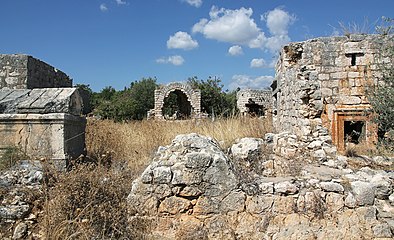Elaiussa Sebaste
Ελαιούσα Σεβαστή | |
 Theatre in Elaiussa Sebaste | |
| Alternative name | Elaeousa Sebaste |
|---|---|
| Location | Mersin Province, Turkey |
| Region | Cilicia |
| Coordinates | 36°29′01″N 34°10′25″E / 36.483624°N 34.173725°E |
| Type | Settlement |
| History | |
| Founded | 2nd century BCE |
| Cultures | Cappadocian, Roman, Byzantine |
| Site notes | |
| Condition | In ruins |
Elaiussa Sebaste or Elaeousa Sebaste (Greek: Ελαιούσα Σεβαστή) was an ancient Roman town located 55 km (34 mi) from Mersin in the direction of Silifke in Cilicia on the southern coast of Anatolia (in the modern-day town of Ayaş, Erdemli District).
Elaiussa (Ελαιούσα), derives from the word elaion (ἔλαιον), meaning oil in Greek (Elaiussa had many olive trees).[1] It was founded in the 2nd century BC on a tiny island attached to the mainland by a narrow isthmus in the Mediterranean Sea.
Besides the cultivation of olives, the settlement here of the
The island that was the site of the first settlement here, where excavations have been underway since 1995 headed by
On the opposite side of the highway
The ruins of Elaiussa Sebaste also harbor the richest and most impressive necropolis among the cities of ancient Cilicia. The "Avenue of Graves", located on a hill to the north of the city, preserves close to a hundred graves of various shapes and sizes scattered among the lemon trees. The aesthetic forms of these monumental graves of Cilicia Tracheia are remarkable.
The ancient aqueducts that carried water to the ruins from the Lamos ("Lemon") river also adorn the city's two entrances. The aqueduct to the west of the city in particular is in relatively good condition. Centuries ago these aqueducts formed a canal system that ran all the way to Corycus.
A lidded sarcophagus lies on a small rise exactly opposite the aqueduct. Known as "the Grave of the Princess", this sarcophagus is a prime example of the Anatolian tomb tradition.
Gallery
-
Temple
-
Necropolis
-
Agora
-
Byzantine Palace
-
Harbour Bath
-
Aqueduct
External links
- The official website of the Italian mission of "La Sapienza" University of Rome Archived 2020-07-30 at the Wayback Machine
- Archaeological web site
References
- ISBN 978-9944483230.
- Edwards, Robert W., "Sebaste (Cilicia)" (2016). The Eerdmans Encyclopedia of Early Christian Art and Archaeology, ed., Paul Corby Finney. Grand Rapids, Michigan: William B. Eerdmans Publishing. pp. 489–491. ISBN 978-0-8028-9017-7.)
{{cite book}}: CS1 maint: multiple names: authors list (link - "Elaeousa Sebaste". Encyclopedia of the Hellenic World (Volume 1, Asia Minor ed.). Foundation of the Hellenic World. 2006. Archived from the original on 2007-10-08.
- Skylife October 2005, a periodical of Turkish Airlines







